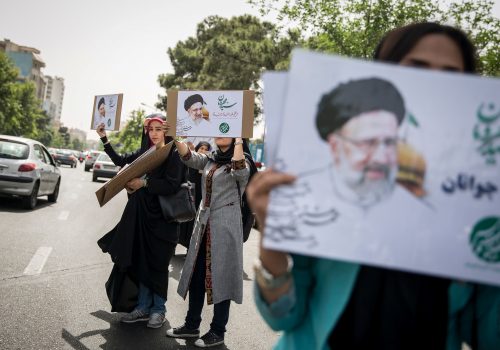For Ebrahim Raisi, Iran’s presidency is a step toward Supreme Leader
With the end of registration for Iranian presidential candidates on May 15, the country appears to have reverted to the pattern from 1989 to 1997—anointing one individual and ending a rudimentary two-party system.
Prior to the upset election of Mohammad Khatami in 1997, one favored candidate predominated: Ali Akbar Hashemi Rafsanjani in 1989 and 1993. From 1997 until this year, elections were heavily contested between hardliners and reformist-moderates.
This time, as expected, Parliamentary Speaker Mohammad Baqer Qalibaf did not register to avoid siphoning votes from Judiciary Chief Ebrahim Raisi, the candidate favored by Supreme Leader Ayatollah Ali Khamenei.
Approximately 590 people, including forty women, registered in the five-day period but most will be eliminated by the Guardian Council, a body controlled by the Supreme Leader. Council member Tahan Nazif has already said that “there may be seven to ten qualified candidates in the elections.” Marginal candidates are expected to drop out before the June 18 vote.
Besides Raisi, the most prominent individuals registering were former Parliament Speaker Ali Larijani; First Vice President Eshaq Jahangiri; Tehran city council member and Rafsanjani’s son, Mohsen Hashemi; former President Mahmoud Ahmadinejad; and former Deputy Minister Mostafa Tajzadeh. The latter two are certain to be refused permission to run by the Guardian Council. Foreign Minister Mohammad Javad Zarif, who had been encouraged by some in the reformist-moderate camp to enter the race, posted a long comment on his Instagram account, telling the Iranian people that his decision not to take part was “in the interest of the country and the nation.” He also said to his political rivals, “Now that you are certain that I will not run, allow me to focus on the Vienna talks [on reviving the 2015 nuclear deal] and sanctions removal.”
The lack of suspense over what many are calling a selection rather than an election has been clear for some time. On May 11, the day registration started, the Supreme Leader, in a speech to university students, listed the qualities of a suitable president: “Religious, revolutionary, popular, hopeful, believer in the youth and domestic potentials, a supporter of justice and actively anti-corruption.”It isno coincidence that these are the same words that Raisi’s supporters have been using to describe him.
Of course, there is always the possibility that the Supreme Leader may change his mind about Raisi but that appears unlikely. Raisi is also the favorite to succeed Khamenei when he dies, following the pattern set when Khamenei, who served as president in the 1980s, replaced Ayatollah Ruhollah Khomeini in 1989.
Unless there is an unexpected development that boosts public enthusiasm, turnout will likely be anemic, even lower than the 63 percent that voted in 1993 and possibly no more than a third of the electorate of roughly 60 million. That means Raisi would need only about ten million votes to win—hardly a ringing endorsement and less than the almost sixteen million votes he got in 2017 when he lost to incumbent Hassan Rouhani.
One key question for analysts is the impact of the elections on the slow-moving Vienna talks. Having set the stage for a Raisi victory next month, it would appear that Khamenei has no reason to impede a swift resolution over differences with the US about returning to compliance with the Joint Comprehensive Plan of Action. On the contrary, he may even want to speed things up, reasoning that Raisi would benefit from any optimism about an economic reopening. Khamenei may even make some gestures on the human rights front or Iranian regional policies to improve the chances for a successful Raisi presidency. The Islamic Republic has shown itself time and again to be extremely pragmatic when its survival was in doubt.
Another likely outcome of a Raisi win would be the inception of a less ideological phase in Iran. Ideologies are good instruments for control, suppression, and propaganda but are less useful when they become costly to implement. In the mid-2000s, Ahmadinejad could afford his ideology-driven populism because oil was at $140 a barrel while the budgeted figure was only $85. That is no longer a realistic prospect.
Raisi and other hardliners have accused Rouhani of failing to implement a “resistance economy” in the face of US sanctions. But they may scrap this posture if they consolidate power. A real improvement in Iran’s economy will require fundamental changes to attract foreign investment and further decrease dependence on the oil sector. This may even manifest itself in the gradual fading of anti-American and anti-Israeli policies and slogans. As long as reformists don’t get credit for the changes, “hardliners” can soften stances that have never had much popular support.
For Raisi, an election win also puts him one step closer to the real top job in Iran. He can be expected to work to consolidate his position in the main power centers, including the military and security forces. He will also strive to achieve more religious legitimacy by attracting the support of the top ayatollahs in Qom and Mashhad, where his father-in-law is Friday prayer leader and grand imam of an important Shia Muslim shrine.
In the forty-two-year history of the Islamic Republic, the first president was deposed and the second was killed in a terrorist bombing. All the other presidents served two four-year terms. If this pattern holds, Khamenei will either have died or be too fragile to continue as Supreme Leader by the time Raisi finishes a second term. Raisi would then be at the top of a very short list to succeed Khamenei.
The author, who is well versed in the Iranian political scene, asked to remain anonymous.
Image: Chief Justice of Iran, Sayyid Ebrahim Raisi is registering for the presidential election 2021 in Tehran, Iran on May 15, 2021. Presidential elections are scheduled to be held in Iran in June 18, 2021. (Photo by Sobhan Farajvan / Pacific Press/Sipa USA)


